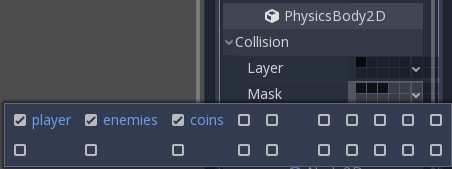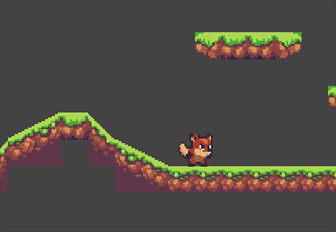Godot 3.0: Using KinematicBody2D
Tue, Feb 13, 2018
Godot offers a number of collision objects to provide both collision detection and response. Trying to decide which one to use for your project can be confusing. You can avoid problems and simplify development if you understand how each each works and what their pros and cons are. In this tutorial, we’ll look at the KinematicBody2D node and show some examples of how it can be used.
Introduction: Physics bodies
In game development you often need to know when two objects in the game space intersect or come into contact. This is known as collision detection. When a collision is detected, you typically want something to happen. This is known as collision response.
Godot offers three kinds of physics bodies, grouped under the PhysicsBody2D type:
StaticBody2D
A static body is one that is not moved by the physics engine. It participates in collision detection, but does not move in response to the collision. This type of body is most often used for objects that are part of the environment or that do not need to have any dynamic behavior.
RigidBody2D
This is the node that implements simulated 2D physics. You do not control a RigidBody2D directly, but instead you apply forces to it (gravity, impulses, etc.) and the physics engine calculates the resulting movement. See Godot 3.0: Rigid Bodies for more information.
KinematicBody2D
A body that provides collision detection, but no physics. All movement must be implemented in code.
Collision shapes
A physics body can hold any number of Shape2D objects as children. These shapes are used to define the object’s collision bounds and to detect contact with other objects.
Note: In order to detect collisions, at least one
Shape2Dmust be assigned to the object.
The most common way to assign a shape is by adding a CollisionShape2D or CollisionPolygon2D as a child of the object. These nodes allow you to draw the shape directly in the editor workspace.
Note: Be careful to never scale your collision shapes in the editor. The
Scaleproperty in the Inspector should remain at(1, 1). When changing the size of the collision shape, you should always use the shape’s handles, not theNode2Dscale handles. Changing the scale can result in unexpected collision behavior.
!player_coll_shape.png
Collision Layers and Masks
One of the most powerful but frequently misunderstood collision features in Godot is the collision layer system. This system allows you to build up very complex interactions between a variety of objects. The key concepts are layers and masks. Each CollisionObject2D has 32 different physics layers it can interact with.
Let’s look at each of the properties in turn:
collision_layerdescribes the layers that the object appears in. By default, all bodies are on layer1.collision_maskdescribes what layers the body will scan for collisions. If an object isn’t in one of the mask layers, the body will ignore it. By default, all bodies scan layer1.
You can also assign names to layers. In “Project Settings”, look for the “Layer Names -> 2D Physics” section:
A body’s layer properties can be configured via code, or directly in the Inspector:
Example:
You have three nodes with the following configuration:
| Layers | Mask | |
|---|---|---|
| Player | 1 |
2, 3 |
| Enemy | 2 |
1 |
| Coin | 3 |
1 |
In this scenario, the Player node would detect collisions with both Enemy and Coin nodes (because they are in layers it scans). However, Enemy and Coin nodes would not detect each other, because they only scan layers they are not in.
Kinematic Bodies
KinematicBody2D is for implementing bodies that are to be controlled via code. They detect collisions with other bodies when moving, but are not affected by engine physics properties like gravity or friction. While this means that you have to write some code to create their behavior, it also means you have more precise control over how they move and react.
Note: A
KinematicBody2Dcan be affected by gravity and other forces, but you must calculate the movement in code. The physics engine will not move aKinematicBody2D.
Movement and collision
When moving a KinematicBody2D, you should not set its position directly. Instead, you use the move_and_collide() or move_and_slide() methods. These methods move the body along a given vector and will instantly stop if a collision is detected with another body. After a KinematicBody2D has collided, any collision response must be coded manually.
Note: Kinematic body movement should only be done in the
_physics_process()callback.
move_and_collide
This method takes one parameter: a Vector2 indicating the body’s relative movement. Typically, this is your velocity vector multiplied by the frame timestep (delta). If the engine detects a collision anywhere along this vector, the body will immediately stop moving. If this happens, the method will return a KinematicCollision2D object.
KinematicCollision2D
When a KinematicBody2D detects a collision, Godot provides a KinematicCollision2D object. This object contains data about the collision and the colliding object. Using this data you can calculate your collision response.
move_and_slide
The move_and_slide() method is intended to simplify the collision response in the common case where you want one body to slide along the other. This is especially useful in platformers or top-down games, for example.
NOTE:
move_and_slide()automatically calculates frame-based movement usingdelta. Do not multiply your velocity vector bydeltabefore passing it tomove_and_slide().
In addition to the velocity vector, move_and_slide takes a number of other parameters allowing you to customize the slide behavior:
floor_normal - default value: Vector2( 0, 0 )
This parameter allows you to define what surfaces the engine should consider to be the floor. Setting this lets you use the is_on_floor(), is_on_wall(), and is_on_ceiling() methods to detect what type of surface the body is in contact with. The default value means that all surfaces are considered walls.
slope_stop_min_velocity - default value: 5
This is the minimum velocity when standing on a slope. This prevents a body from sliding down a slope when standing still.
max_bounces - default value: 4
This is the maximum number of collisions before the body stops moving. Setting this too low may prevent movement entirely.
floor_max_angle - default value: 0.785398 (in radians, equivalent to 45 degrees)
This is the maximum angle before a surface is no longer considered a “floor”.
Which to use?
A common question from new Godot users is: “How do you decide which movement function to use?”
Often the response is to use move_and_slide() because it’s “simpler”, but this is not
necessarily the case. One way to think of it is that move_and_slide() is a special case,
and move_and_collide() is more general. For example, the following two code snippets result in the same collision response:
var collision = move_and_collide(velocity * delta)
if collision:
velocity = velocity.slide(collision.normal)velocity = move_and_slide(velocity)Anything you do with move_and_slide() can also be done with move_and_collide(),
it just might take a little more code. However, as we’ll see in the examples below,
there are cases where move_and_slide() isn’t the response you want.
Examples
Download the Sample Project for the examples below.
Basic movement
If you’ve downloaded the sample project, this example is in the “BasicMovement.tscn” scene.
For this example, Add a KinematicBody2D with two children: a Sprite and a CollisionShape2D. As with many demos, we’ll use the Godot “icon.png” as the Sprite’s texture (drag it from the Filesystem dock to the “Texture” property of the Sprite). In the CollisionShape2D’s “Shape” property, select “New RectangleShape2D” and size the rectangle to fit over the sprite image.
Attach a script to the KinematicBody2D and add the following code:
extends KinematicBody2D
var speed = 250
var velocity = Vector2()
func get_input():
# Detect up/down/left/right keystate and only move when pressed
velocity = Vector2()
if Input.is_action_pressed('ui_right'):
velocity.x += 1
if Input.is_action_pressed('ui_left'):
velocity.x -= 1
if Input.is_action_pressed('ui_down'):
velocity.y += 1
if Input.is_action_pressed('ui_up'):
velocity.y -= 1
velocity = velocity.normalized() * speed
func _physics_process(delta):
get_input()
move_and_collide(velocity * delta)Run this scene and you’ll see that move_and_collide() works as expected, moving
the body along the velocity vector. Now let’s see what happens when you add
some obstacles. Add a StaticBody2D with a rectangular collision shape. For visibility,
you can use a sprite, a Polygon2D, or just turn on “Visible Collision Shapes” from
the “Debug” menu.
Run the scene again and try moving into the obstacle. You’ll see that the KinematicBody2D
can’t penetrate the obstacle. However, try moving into the obstacle at an angle and
you’ll find that the obstacle acts like glue - it feels like the body gets stuck.
This happens because there is no collision response. move_and_collide() just stops
the body’s movement when a collision occurs. We need to code whatever response we
want from the collision.
Try changing the function to move_and_slide(velocity) and running again. Note that we removed delta from the velocity calculation.
move_and_slide() provides a default collision response of sliding the body along the
collision object. This is useful for a great many game types, and may be all you need
to get the behavior you want.
Next, we’ll look at a few other examples.
Bouncing/reflecting and collision detection
What if you don’t want a sliding collision response? For this example (“BounceandCollide.tscn” in the sample project), we have a character shooting bullets and we want the bullets to bounce off the walls.
For this example, we have three scenes: the main scene containing the Player, a Bullet, and a Wall. The Bullet and Wall are separate scenes so that they can be instanced.
The Player is controlled by W/S for forward/back and aims using the mouse. Here is
the code for the Player, using move_and_slide():
extends KinematicBody2D
export (PackedScene) var Bullet
export (int) var speed
var velocity = Vector2()
func get_input():
# add these actions in Project Settings -> Input Map
velocity = Vector2()
if Input.is_action_pressed('backward'):
velocity = Vector2(-speed/3, 0).rotated(rotation)
if Input.is_action_pressed('forward'):
velocity = Vector2(speed, 0).rotated(rotation)
if Input.is_action_just_pressed('mouse_click'):
shoot()
func shoot():
# "Muzzle" is a Position2D placed at the barrel of the gun
var b = Bullet.instance()
b.start($Muzzle.global_position, rotation)
get_parent().add_child(b)
func _physics_process(delta):
get_input()
var dir = get_global_mouse_position() - global_position
# Don't move if too close to the mouse pointer
if dir.length() > 5:
rotation = dir.angle()
velocity = move_and_slide(velocity)And the code for the Bullet:
extends KinematicBody2D
var speed = 750
var velocity = Vector2()
func start(pos, dir):
rotation = dir
position = pos
velocity = Vector2(speed, 0).rotated(rotation)
func _physics_process(delta):
var collision = move_and_collide(velocity * delta)
if collision:
velocity = velocity.bounce(collision.normal)
if collision.collider.has_method("hit"):
collision.collider.hit()
func _on_VisibilityNotifier2D_screen_exited():
queue_free()The action happens in _physics_process(). After using move_and_collide() if a
collision occurs, a KinematicCollision2D object is returned (otherwise, the return
is Nil).
If there is a returned collision, we use the normal of the collision to reflect
the bullet’s velocity. bounce() is a Vector2 method.
If the colliding object (collider) has a hit method,
we also call it. In the example project, we’ve added a flashing color effect to
the Wall to demonstrate this.
Platforming with move_and_slide
Let’s try one more example - one that often gets asked about - the 2D platformer. move_and_slide() is ideal for quickly getting a functional character controller up and running. If you’ve downloaded the sample project, you can find this in “Platformer.tscn”.
For this example, we’ll assume you have a level made of StaticBody2D objects. They can be any shape and size. In the sample project, we’re using a TileMap to lay out the level, but for the purposes of this demo, they could just as well be individual static bodies.
We’re also using the adorable “Sunny Land” art pack by Ansimuz for the art and character animations.
Here’s the code for the player body:
extends KinematicBody2D
export (int) var run_speed
export (int) var jump_speed
export (int) var gravity
enum {IDLE, RUN, JUMP}
var velocity = Vector2()
var state
var anim
var new_anim
func _ready():
change_state(IDLE)
func change_state(new_state):
state = new_state
match state:
IDLE:
new_anim = 'idle'
RUN:
new_anim = 'run'
JUMP:
new_anim = 'jump_up'
func get_input():
velocity.x = 0
var right = Input.is_action_pressed('ui_right')
var left = Input.is_action_pressed('ui_left')
var jump = Input.is_action_just_pressed('ui_select')
if jump and is_on_floor():
change_state(JUMP)
velocity.y = jump_speed
if right:
change_state(RUN)
velocity.x += run_speed
if left:
change_state(RUN)
velocity.x -= run_speed
$Sprite.flip_h = velocity.x < 0
if !right and !left and state == RUN:
change_state(IDLE)
func _process(delta):
get_input()
if new_anim != anim:
anim = new_anim
$AnimationPlayer.play(anim)
func _physics_process(delta):
velocity.y += gravity * delta
if state == JUMP:
if is_on_floor():
change_state(IDLE)
velocity = move_and_slide(velocity, Vector2(0, -1))
if position.y > 600:
get_tree().reload_current_scene()We’re using a very rudimentary state machine to handle the transitions between the character’s idle, running, and jumping states.
When using move_and_slide() the function returns a vector representing the
movement that remained after the slide collision occurred. Setting that value back
to the character’s velocity allows us to smoothly move up and down slopes. Try
removing velocity = and see what happens if you don’t do this.
Also note that we’ve added Vector2(0, -1) as the floor normal. This is a vector
pointing straight upward. This means that if the character collides with an object
that has this normal, it will be considered a floor.
Using the floor normal allows us to make jumping work, using is_on_floor(). This
function will only return true after a move_and_slide() collision where the
colliding body’s normal is within 45 degrees of the given floor vector (this can
be adjusted by setting floor_max_angle).
This also allows you to implement other features like wall jumps using is_on_wall(),
for example.
Conclusion
This introduction only scratches the surface of what’s possible with KinematicBody2D. As with all Godot nodes, the API documentation is your friend, so reference it frequently until you’re comfortable with the class methods.
Kinematic bodies are so useful, that I’ll probably do a followup “Know Your Nodes” exploring more uses. Please comment below if you have ideas or suggestions for other examples you’d like to see.





